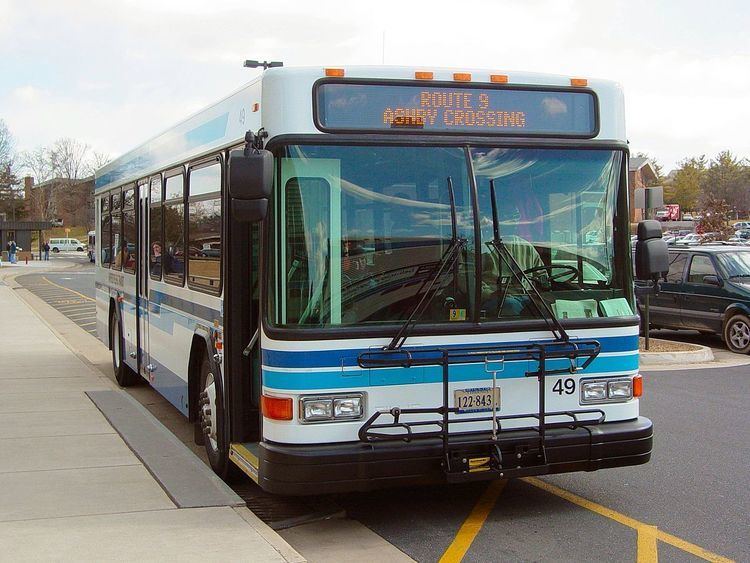Manufacturer Gillig Corporation Body style Single-decker bus | Production 1996–present Class Transit bus | |
 | ||
Also called Gillig H2000LFGillig Advantage | ||
The Gillig Low Floor (originally named Gillig H2000LF and also nicknamed Gillig Advantage) is a transit bus manufactured by the Gillig Corporation. The second low-floor bus introduced in the United States (after the New Flyer LF), the Low Floor has been produced since 1997. Originally produced alongside the Gillig Phantom as an expansion of the transit product range, the Low Floor has become the successor to the Phantom and the sole Gillig bus platform since 2008.
Contents
The Gillig Low Floor is assembled in Hayward, California.
Design History
The Gillig Low Floor began life in the mid-1990s as Gillig was approached by Hertz Corporation to develop a shuttle bus for its rental car parking lots at airports to replace its aging GMC RTS buses. Featuring a carpeted interior, luggage racks, and a central entry door, the primary design requirement of Hertz was a low-floor entry for those carrying luggage or with limited mobility. In 1996, the first buses for Hertz (named the Gillig H2000LF) entered production. Gillig would produce the H2000LF for Hertz through 2005, as the design was replaced by standard Gillig Low Floor buses.
In 1997, Gillig modified the H2000LF design for use as a transit bus, adding dual entry doors with no front entrance. The non-Hertz buses were named the Gillig Low Floor, introduced alongside the step-entrance Gillig Phantom.
During its production, the Gillig Low Floor has seen revisions to its body design. In 2002, the windshield was enlarged (along with the use of a smaller destination sign) and the side windows were reduced in width. In 2008, the glass of both entry doors was enlarged (distinguished by squared-off corners). A suburban configuration was added, identified externally by the lack of a rear entry door. In place of transit seating, the configuration is equipped with forward-facing seating, internal luggage racks, onboard Wi-Fi, and other passenger-related options.
Overview
Of the two body configurations for low-floor buses, the Gillig Low Floor is a low-entry bus (the front ⅔-¾ of the interior is low-floor) with a low-step entry (nearly curb height) and integrated wheelchair ramp while the rear part of the interior is raised to provide sufficient space for the powertrain.
The Gillig Low Floor is produced in three body lengths in its standard transit bus configuration, with 29 ft (8.8 m), 35 ft (10.7 m), and 40 ft (12.2 m) lengths available. Maximum seating capacity is 28 for the 29-foot bus (with seats over the front axle), 32 for the 35-foot bus, and 40 for the 40-foot bus. The turning radius of the Gillig Low Floor is 29 ft (8.8 m) (29 foot body), 36 ft (11.0 m) (35 foot body), and 43 ft (13.1 m) (40 foot body).
Powertrain
Currently (as of 2017), the Gillig Low Floor range is equipped with three engines: the Cummins ISB6.7 diesel, Cummins ISL diesel, and Cummins ISL-G compressed natural gas inline-six engines. Throughout its production, the Gillig Low Floor has featured a range of Cummins engines along with Caterpillar and Detroit Diesel engines.
Since 2004, the Gillig Low Floor has been available in a diesel-electric hybrid configuration with the Cummins ISB engine; hybridmodels are identified by their roof-mounted battery pack.
Depending on variant, the Gillig Low Floor is produced with a range of Allison, Voith, and ZF automatic transmissions; hybrid models are produced with Allison, Voith, and ZF hybrid-drive powertrains.
Variants
Gillig also manufactures three models of buses based on the Low Floor chassis: the Low Floor BRT, the Low Floor BRTPlus, and the Low Floor Trolley. All have the same engine and transmission options as the standard Low Floor.
Gillig BRT
The Gillig BRT is a restyled version of the Low Floor with different front and rear fascias. It wears a more futuristic look than the standard model. It is available in the same lengths as the standard Low Floor model, although the front fascia adds roughly an extra foot of length to the bus. Instead of sealed-beam headlights, the Gillig BRT has projector headlights. The layout for the headlights was changed slightly in 2009. The Gillig BRT is available with CNG, Diesel and Diesel-Electric Hybrid drivetrains. The first of BRTs of this version went to LeeTran in Lee County, Florida.
The design of the BRT allows for some degree of customization by the purchaser. Some BRTs have been ordered with the same rear end as the standard Low Floor model. Although the BRT can be ordered without the frameless side windows, most BRTs are equipped with them. A one-piece windshield is another popular option for the BRT.
Gillig BRTPlus
The Gillig BRTPlus is a variant of the BRT which features a streamlined fuel tank & A/C above the roof. The Plus made its debut in 2011 with Long Beach Transit #1201, which is also the first Compressed Natural Gas (CNG) BRT produced. The BRTPlus is available with CNG, Diesel and Diesel-Electric Hybrid drivetrains.
Gillig Trolley Replica
The Gillig Trolley is produced in collaboration with Cable Car Classics of Healdsburg, California. It is available in 30 ft (9.1 m), 35 ft (10.7 m), and 40 ft (12.2 m) lengths. The vintage-style trolley appearance package exterior features include frameless bonded side windows, maintenance-free wood-like trim, ornate gold pinstriping, custom window and body graphic decals, roof cupola, functional solid brass bell, cow catcher, roof perimeter LED ropelights, and front center brass trolley lamp. The interior has solid American white oak seats, optional seat cushions, leather hand straps, brass handrails, stop request pull ropes, wood trim, and woodgrain wall panels and floor covering. In addition to conventional diesel, the Gillig Trolley is available with optional power trains, including Allison hybrid-electric, all-electric, and CNG.
